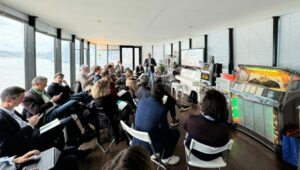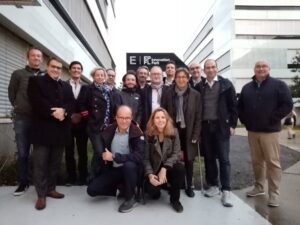💡 Energy and mobility: life cycles
💡 Energy and mobility: life cycles
Energy and mobility : life cycles was the theme of this Futura-Mobility session, attended by some 30 participants on 8 December 2017.
Taking a comprehensive approach, we explored the topic in terms of energy (already broached in June 2017), the greenhouse effect, and materials used throughout service lives : from design to end-of-life for every kind of vehicles and infrastructure – on water, wheels and in the skies.
Facing up to finitude
“Today we are at the heart of a fossil-fuel civilisation that needs reinventing.” Geneviève Férone-Creuzet, pionner in responsible financing, founder of Casabee and author of ‘Le crépuscule fossile’, set the scene for the meeting by singling out the American John Davison Rockefeller (1839-1937) as “the father of this fossil-fuel civilisation”, an extractive civilisation based on a product both abundant and easy to exploit.
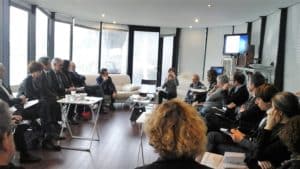
If Rockefeller and his generation had been aware that resources like oil might well diminsh over the decades, they would have certainly paid closer attention to ‘Earthship’, the 1950’s book whose author was the first to sound the alarm on oil reserves and their limitations, as well as the risks of depending too heavily on a resource incapable of guaranteeing our future. But at that time, nobody was listening.
“Oil pervades every aspect of our lives” – it’s in plastic objects, cosmetics, and vehicles of course…. It remains central to all major geopolitical and military (in)stability. “We are still in the grips of a terrible dependency,” pointed out Ms Férone-Creuzet. “How come oil sidesteps any form of democratic governance?!”
She compared this situation to today’s data economy, which like for oil, is also an extractive economy. “We extract data like oil. It is free, and we are… the product.”
“The majority of us aren’t sufficiently, if at all aware of resource depletion. Just look at how we live on a day-to-day basis,” said Christine Guinebretière, president, EPEA Paris, during her presentation on cradle-to-cradle (C2C) – the ecological methodology for conceiving products or processes that are both carbon neutral for the environment and deliver positive impacts.

On the topic of depletion, she pointed out that oil isn’t the only resource concerned, but equally the metalloids (chemical elements with properties between those of metals and non-metals) generally used by industry in alloys. Take cars, for instance…
“Tesla isn’t a good model; its cars are tanks on wheels [so use a lot of materials to build],” complained Claude Turmes, European Parliament member from Luxembourg for the Greens (Dei Greng). “The problem we face is how to introduce legislation preventing the electric car from becoming the gateway for people to drive around in tanks!”
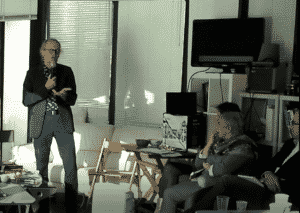
Warning signs on the seas and in space
“Around 300 cargo ships are scrapped every three months. This represents a convoy of about 30 to 50km long. And 80 to 95% of these ships end up on the shores of the Asian continent.”
Jacky Bonnemains, president of the green association Robin des Bois, deplored the lack of ship-breaking yards in the Eastern Mediterranean, i.e. Spain, France, and countries in North Africa. “There isn’t a single yard, not even in Greece, despite it being a leader in shipping and maritime traffic.”

For shipbuilders and the marine environment, the most noxious elements are asbestos, the presence of polychlorinated biphenyls (PCB) in the paint and electric cabling, and toxic coatings. In theory, the Hong Kong Convention, an international agreement for the safe and environmentally sound recycling of ships adopted in 2009, should have made a difference. But since insufficient countries have signed up, it has never been enforced.
When will we see ship-breaking yards in the Mediterranean?
And it’s not any better out in space, where the approach appears to be based on ‘out of sight, out of mind’ thinking. With so much debris in orbit, the risk of collisions between satellites or the International Space Station – especially when its astonauts are spacewalking – is high, and rising.
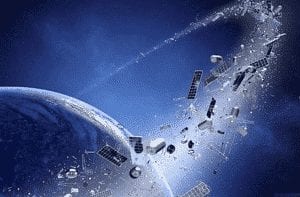
“This junk remains in space, depending on its orbit, from a few hours when under 200km from Earth to several centuries when over 1,000km!” explained Jean-Pierre Haigneré, astronaut with the European Space Agency (ESA).

One of the biggest debris incidents to date, which occured during trials of a Chinese anti-satellite missile in 2007, spilled 2,300 visible fragments of debris, 35,000 fragments less than 1cm, and over one million smaller than 1mm.
This mishap was all the more serious since it took place at a higher altitude, 850km, than previous trials of such weapons; meaning the fragments will remain in orbit for 35 years at the very least.
In June 2007, the Terra satellite was the first to be diverted to avoid being hit by this junk.
- RemoveDebris: space junk mission prepares for launch
- China’s runaway Tiangong-1 space station set to crash to Earth in March 2018
“With 80 launches a year, plus nano- and micro-satellites coming onstream, not to mention mega-constellations of thousands of communication satellites, the amount of junk in orbit is increasing dramatically,” warned Mr Haigneré. “And this is despite existing rules at European level involving the United Nations, NASA and CNES [French National Centre for Space Studies].”
Complex life cycle analysis
From the viewpoint of manufacturers, “if we want to do something for the environment, engineers need calcuation tools for life cycles they can understand,” said Agnès Jullien, deputy director, European & International Affairs, IFSTTAR.

“There’s little in-house analytical data on the life cycles of the various materials used across the network,” explained Benoît Aliadière, head of eco-design at SNCF Réseau, the French rail network manager, “But we do have a better understanding of certain aspects, such as electric traction with copper and transformers.”

SNCF Réseau & the environment – from design to maintenance
At Airbus, the many parameters that must be taken into account include noise C02 emissions, energy consumption, and the use of materials.
From research to production, the group has put in place a comparative analysis process for life cycles in order to assist with decision-making. But it’s the regulations and certification that impose the priorities, particularly when it comes to C02 emissions. Consequently, when it comes to introducing a new material, “we will use a composite instead of metal because it is lighter and emits less CO2. Then we explore how to limit the impacts of using it,” said Marie-Pierre Vicomte, environmental director at Airbus.

Making progress in recycling
According to François Roudier, communications director, Comité des Constructeurs Français d’Automobiles (CCFA), over the past 10 to 15 years the automotive sector has established a genuine (backed by business logic) circular economy for recycling its vehicles. “Recycling is now fully integrated into the overall system. Materials are selected by engineers based on their residual value with regards the future life of the car.”

“Let’s not ignore a crucial element – why are car manufacturers recycling?” spoke out Mr Turmes. “Because of European law! Europe with its legislation is the origin and driving force behind recycling.”
As electric vehicles come to market, grey areas are emerging over batteries and their second lives – “a topic we don’t talk enought about,” points out François-Michel Lambert, president-founder, Institut de l’Economie Circulaire; Green representative for Bouches-du-Rhône French department; and president, Commission Nationale France Logistique 2025.
“For example, Renault owns its batteries. So in 20 years, when they reach the end of their first life, the group can then extract rare metals and other critical elements from them. By so doing, constructors can become ‘holders’ of mined resources that will be in shorter supply within the next two decades.”
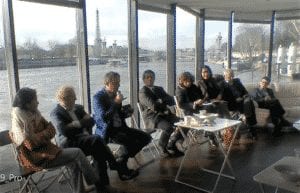
Mr Aliadière said SNCF Réseau is well versed in reusing key elements such as rails – “by redeploying them on smaller [less traffic] tracks, selling them for scrap” – and ballast – “the highways know how to use it for base layers in road construction, plus 60% of the ballast removed during track renewal is then put down on smaller tracks subject to fewer constraints.”
At the Airbus factories, waste composites are reused or recycled either in-house or externally.
How about changing tack?
Ms Guinebretière believes “it’s high time industry starting thinking how to design products so it can retrieve the metolloids it can’t do without.”
As far as Mr Turmes is concerned, the idea of creating completely closed life cycles is only feasible if the input is ‘clean’; and this is the big challenge. “From the start we must define the parameters of these ‘clean’ substances and elements,” he said. “Firstly, it calls for bold political measures to outlaw things in order to lay the foundations for a recycling society.”
For example, with regards the life cycles of electric vehicles he considers it most important to focus on the source(s) of the electricity. “I’m in the process of negotiating a new European law on renewable energies and have obtained an amendment that basically says: one million electric cars means 2.4 terraWatt-hours of electricity, so every Member State that puts one million of these cars on the roads must create new investment equivalent to 2.4 terraWatt-hours. It’s vital to be able say the electricity for these new vehicles comes in part from renewables.”
Looking to the future, SNCF Réseau “will be working towards creating an ecosystem, together with manufacturers in the rail sector, our suppliers, to incorporate more elements based on recycling into the network,” said Mr Aladière. Airbus is on a similar track, added Ms Vicomte: “We are trying to use bio-composites to limit our dependency on it, and to develop bio-sourced materials – with a matrix and resin not based on oil.”
Up until now, sustainable development was seen as about reducing the impacts of the activities in question,” said Ms Guinebretière. “But what if we did the opposite? The human species isn’t separate from nature. We are perfectly capable of thinking up and seeking out the biggest positive impacts for ourselves, and the planet.”
Real-life examples of this approach already exist, such as the C2C teeshirts by clothing retailer C&A and carpets by Desso. And Ms Guinebretière, for one, remains upbeat: “I said to the R&D people at a washing powder brand: ‘what if you worked on a powder that when drained with the dirty water started to clean it?’ And guess what, they told me ‘oh we know how to do that’!”
- The next Futura-Mobility session, in February 2018, is on the theme ‘Strategic disruption in the mobility industry’.

